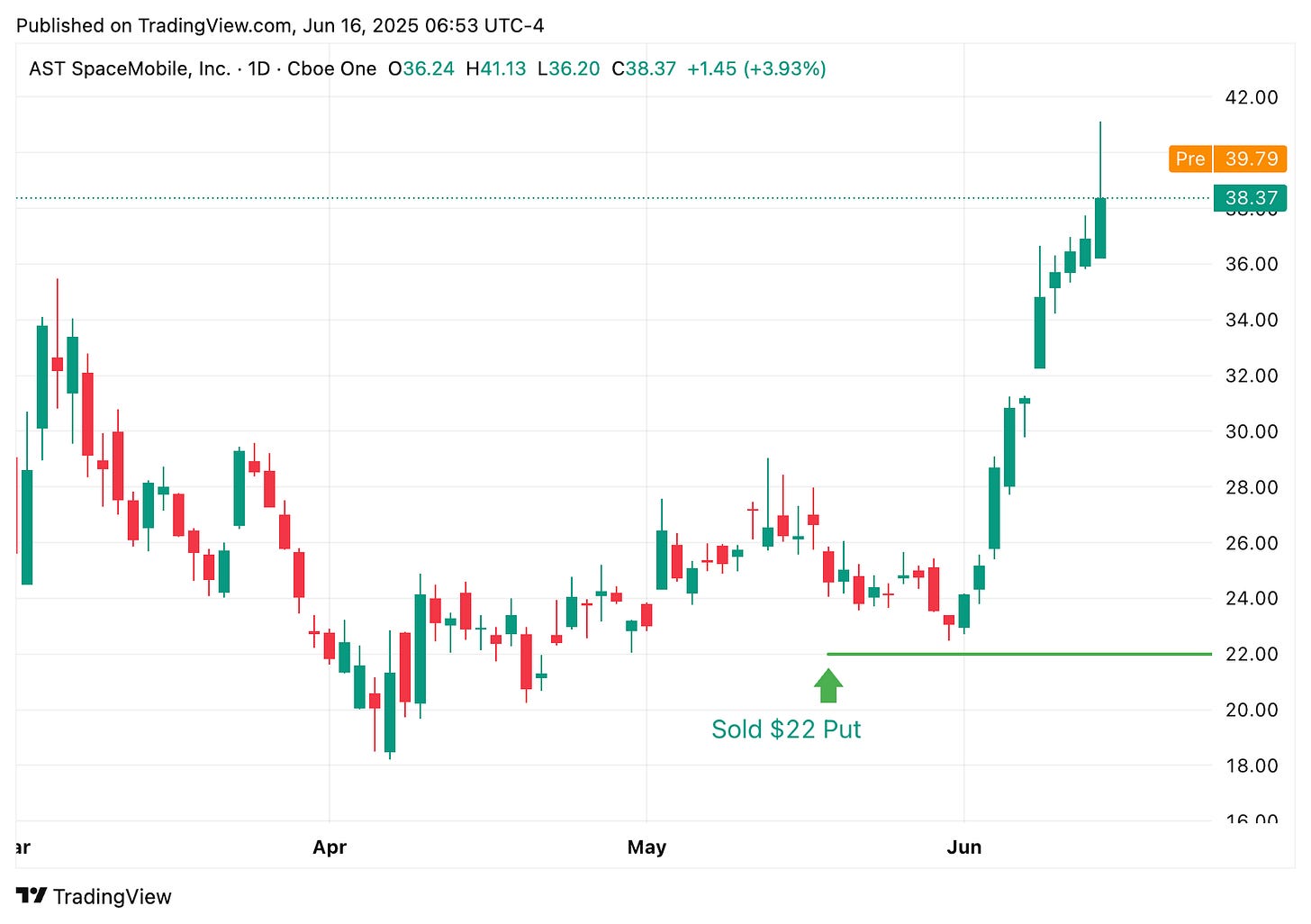Introducing Collateral Compounding
A strategy that builds long-term equity exposure without touching your cash
What If Your Existing Portfolio Could Earn 5% More Per Year?
You already own stocks you believe in. You’re in it for the long haul.
But what if you could quietly add 5% a year to that portfolio — using no extra cash, just the margin capacity you already have?
Over 20 years, earning 10% turns $100,000 into $673,000. Add just 5% more, and that grows to $1.65 million.
Same portfolio. Same convictions. Just smarter compounding. That’s the idea behind Collateral Compounding: a strategy that builds new positions without taking anything away from the ones you already hold.
If you already have a portfolio of stocks you believe in, the last thing you need is another strategy that competes for capital.
Collateral Compounding doesn’t. It supplements what you already own by using margin — not cash — to build new positions at prices we like. We target undervalued stocks after deep corrections, high growth stories, cyclicals that are ready to rebound, and defensive dividend payers you can safely own for years. We sell puts tactically on these names and reinvest the premium into the underlying. No blind selling, no aimless assignments. Over time, we will help you build high conviction positions that could rival — or even outperform — your original holdings.
This isn’t about replacing your strategy. It’s about compounding smarter alongside it.
How This Strategy Works Without Using Any Cash
Collateral Compounding isn’t capital-intensive. You don’t need to sell anything. You don’t need to move cash. You don’t even need to change how you manage your core portfolio.
Instead, this strategy uses the buying power you already have — the margin unlocked by your existing long positions. And it stays entirely within those limits.
No cash outlay.
No interest charges.
No disruption to your current holdings.
You’re not borrowing. You’re not leveraging. You’re simply putting idle buying power to work — collecting premium, reinvesting it into high-quality stocks at attractive valuations, and quietly compounding your long portfolio over time.
And because we only target stocks we’ve pre-screened for quality, valuation, and timing, you’re not just writing random puts. You’re methodically building equity exposure in names we think are worth owning for the next few years.
It’s a side engine — one that builds a second layer of wealth while your main portfolio keeps running, untouched.
A Real-World Example — Turning $0 Into $155 (in Days)
Let’s say you’re starting with a $10,000 portfolio.
We generally recommend allocating about 25% of your portfolio’s long value as your “assignment budget” when getting started — just enough to learn the rhythm of the strategy without overcommitting. On a $10,000 portfolio, that means your first few trades would target about $2,500 of potential assignment risk.
Here’s what that looked like in practice.
On May 19, 2025, we sold the ASTS June 27 $22 put for $1.59 — a total assignment risk of $2,200, comfortably within that 25% threshold.

Just 16 days later, we bought it back for $0.59, locking in our $100 profit target. The trade required no cash outlay — only the ability to take on that obligation — and it closed automatically once our target was hit.
What did we do with that $100?
We reinvested it into ASTS stock, buying 4.10 shares at $24.34. At the time of writing, those shares are trading around $38, turning our $100 premium into $155. That’s a 55% return on the premium alone, and more importantly:
That single trade quietly added 1.5% to the value of our original $10,000 portfolio — in just over two weeks.
And next time?
That 25% assignment budget isn’t based on $10,000 anymore. It’s based on $10,155 — which means we can now take on $2,538 of exposure, and so on.
That’s the idea behind Collateral Compounding: stacking small wins using unused margin capacity to build long-term positions. Repeated patiently, those wins start to add up. And over time, they compound.
Is This a Margin Strategy?
Technically, yes — but not the kind most people worry about.
We’re not borrowing money or paying interest. Instead, this strategy uses your available margin capacity — the reserve of buying power in your account — to secure put positions.
No cash leaves your account.
No loan is issued.
No interest is charged.
Your broker simply sets aside a portion of your portfolio as collateral in case you get assigned. And because we structure trades to avoid assignment, your core capital stays untouched.
So while this strategy uses margin, it’s not leveraged in the traditional sense. It’s a controlled, efficient way to compound equity exposure without disrupting your portfolio.
What This Isn’t
This isn’t the Wheel. And it’s not a cash-secured put strategy.
Cash-secured puts tie up real cash, often sitting idle waiting for a stock to dip. The Wheel repeats a sell-assign-call cycle without much discretion — often selling puts on whatever yields the highest premium.
Collateral Compounding is different. It doesn’t lock up capital. It doesn’t sell indiscriminately. It targets high-conviction names using excess buying power instead of tying up funds.
We don’t chase yield. We don’t roll blindly. We’re building long-term positions — patiently, selectively — using buying power that most portfolios leave idle.
(Want a full breakdown of how the Wheel works — and how this diverges from it? We’ll cover that here soon.)
What You Need to Use This Strategy
To run Collateral Compounding, you’ll need a margin account with approval to sell uncovered puts — typically called Level 3 or Level 4, depending on your broker.
That’s because this strategy uses margin capacity (not cash) to secure put positions. You’re not borrowing, but you are using your portfolio as collateral — and that requires a higher level of options access.
Not sure if you qualify — or how to get approved? We’ve published a full guide that walks you through the process.
Who This Is (and Isn’t) For
Collateral Compounding is a strategy that runs alongside your core portfolio — not in place of it. We don’t dictate how you manage your existing holdings. You can trade them, rebalance them, or leave them alone. That’s your call.
But the positions we help you build — funded by your account’s existing buying power — require a different mindset.
This strategy only makes sense if you’re willing to:
Hold these new positions for at least 2–3 years to allow our thesis to play out
Stay disciplined during drawdowns, especially when volatility spikes
Adjust position sizing if your core portfolio declines, since the buying power we employ is based on that value
These aren’t just trades. They’re equity positions we’re deliberately building — names we’ve screened, studied, and believe are worth owning for years. You didn’t spend cash to get them, but they still deserve your full commitment.
This strategy is not a good fit if:
You expect every position to pay off in a few weeks or months
You’re likely to close a trade just because it’s temporarily underwater
You can’t tolerate volatility in names we’ve screened and selected
You’re unwilling to hold these specific positions — built using margin — for multiple years
If you treat these like just another options income play — chasing premium, closing early, or bailing when things dip — it falls apart. There are plenty of ways to run a yield strategy. This isn’t one of them. What we’re doing is different: building long-term ownership in high-quality companies, one position at a time. And we need you to treat those positions with the respect that long-term ownership requires.
These are not short-term yield plays. They’re long-term equity entries — funded by premium, not capital — and they need time to develop.
If you treat them like trades, the strategy won’t work. But if you’re patient, the compounding will be meaningful.
(Curious how these positions take shape — and how we end up with long-term equity exposure without spending a dime of your capital? We’ll walk through the full mechanics in an upcoming article.)
How Much Time This Takes
This isn’t an active strategy. You’ll typically get just 1-2 setups per week — and each one takes minutes to enter.
Once you get the alert, you:
Sell the put
Set a closing order
Set a rolling alert in your broker platform
After that, it manages itself. Most trades close automatically. If a roll is needed, your platform will let you know — no need to wait for me. Just roll it when the alert comes up. It’s quick and mechanical.
Going on vacation? Pause. I do too. This is a side strategy — not your main focus. I'd rather earn an extra 4% a year and miss a few setups than chase 8% and babysit trades all day.
The point is to compound quietly in the background — without getting in the way.
Where This Is Going
Collateral Compounding isn’t a one-off idea. It’s a full framework — and this is just the start.
In the coming weeks, I’ll walk through every part of the strategy in detail: How I select the names. How I manage the trades. When to roll. Why we pause. What to do when a position goes against you — and what success looks like when it doesn’t.
If you're interested in building long-term positions in quality companies without committing more capital, this strategy can help. It's not magic. It’s just structure, patience, and putting unused buying power to work.
More to come.



